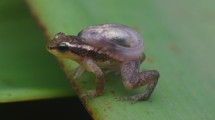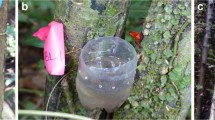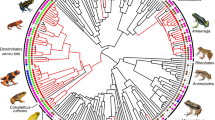Abstract
Parents have to assess the multivariate characteristics of their reproductive sites to maximize their reproductive success through offspring performance. In addition, they may provide care to ensure optimal performance of their offspring. In poison frogs it has been identified that ecological characteristics of reproductive sites may underlie transitions in the involvement of parental sexes in care for offspring. To elucidate the ecological factors that may drive these transitions, it is important to understand which characteristics poison frogs use to assess the quality of their reproductive site. We studied the use of small water bodies in leaf axils of bromeliads, phytotelmata, for egg and tadpole deposition by Amazon poison frogs (Ranitomeya amazonica). We compared phytotelm quality characteristics for preferred egg and tadpole deposition sites and used two choice tests with plastic cups to study the causal relationship with tadpole deposition for the identified characteristics. The differences among quality characteristics of deposition sites were largest among bromeliad species, and for egg or tadpole deposition different bromeliad species were preferred. However, males were also selective in the leaf axils within a bromeliad species that they used for egg or tadpole deposition. Eggs were deposited in small, resource limited water bodies that were close to the forest floor. Tadpoles were deposited in leaf axils holding resource-rich phytotelmata with larger water volumes. Preference of detritus containing water over clear water in choice tests confirmed that Amazon poison frogs assess quality of their tadpole deposition sites on food availability. We conclude that preference for large water volume and resource rich phytotelmata plays an important role in determining male involvement in parental care and speculate that distribution of preferred resources may bring about selection on female involvement in parental care.






Similar content being viewed by others
References
Bechter R, Lescure J (1982) Dendrobates quinquevittatus, Fortpflanzungsverhalten im Terrarium und Vielgestaltigkeit der Art (Teil 1). Herpetofauna 4:26–30
Born MG, Gaucher P (2001) Amphibian and reptile species at the Nouragues Nature Reserve. In: Bongers F, Charles-Dominique P, Forget PM, Théry M (eds) Nouragues dynamics and plant-animal interactions in a Neotropical rainforest. Kluwer Academic Publisher, Dordrecht, pp 371–379
Brown JL, Morales V, Summers K (2008a) Divergence in parental care, habitat selection and larval life history between two species of Peruvian poison frogs: an experimental analysis. J Evol Biol 21:1534–1543
Brown JL, Twomey EM, Morales V, Summers K (2008b) Phytotelm size in relation to parental care and mating strategies in two species of Peruvian poison frogs. Behaviour 145:1139–1165
Brown JL, Morales V, Summers K (2009) Tactical reproductive parasitism via larval cannibalism in Peruvian poison frogs. Biol Letters 5:148–151
Brown JL, Morales V, Summers K (2010) A key ecological trait drove the evolution of biparental care and monogamy in an amphibian. Am Nat 175:436–446
Brown JL, Twomey E, Amézquita A, Barbosa de Souza M, Caldwell JP, Lötters S, von May R, Melo-Sampaio PR, Mejía-Vargas D, Perez-Peña P, Pepper M, Poelman EH, Sanchez-Rodriguez M, Summers K (2011) A taxonomic revision of the Neotropical poison frog genus Ranitomeya (Amphibia: Dendrobatidae). Zootaxa 3083:1–120
Caldwell JP (1997) Pair bonding in spotted poison frogs. Nature 385:211
Caldwell JP, de Oliveira VRL (1999) Determinants of biparental care in the spotted poison frog, Dendrobates vanzolinii (Anura: Dendrobatidae). Copeia 1999:565–575
Clutton-Brock TH (1991) The evolution of parental care. Princeton University Press, Princeton
Crump ML (1991) Choice of oviposition site and egg load assessment by a treefrog. Herpetologica 47:308–315
Dawkins R, Carlisle TR (1976) Parental investment, mate desertion and a fallacy. Nature 262:131–133
Downie JR, Livingstone SR, Cormack JR (2001) Selection of tadpole deposition sites by male Trinidadian stream frogs, Mannophryne trinitatis (Dendrobatidae): an example of anti predator behavior. Herpetol J 11:91–100
Ekbom B, Popov SYA (2004) Host plant affects pollen beetle (Meligethes aeneus) egg size. Physiol Entomol 29:118–122
Fincke OM (1994) Population regulation of a tropical damselfly in the larval stage by food limitation, cannibalism, intraguild predation and habitat drying. Oecologia 100:118–127
Godfray HCJ (1994) Parasitoids: behavior and evolutionary ecology. Princeton University Press, Princeton
Grant T, Frost DR, Caldwell JP, Gagliardo R, Haddad CFB, Kok PJR, Means BD, Noonan BP, Schargel W, Wheeler WC (2006) Phylogenetic systematics of dart-poison frogs and their relatives (Anura: Athesphatanura: Dendrobatidae). B Am Mus Nat Hist 299:1–262
Grimaldi M, Riéra B (2001) Geography and climate. In: Bongers F, Charles-Dominique P, Forget PM, Théry M (eds) Nouragues dynamics and plant-animal interactions in a Neotropical rainforest. Kluwer Academic Publisher, Dordrecht, pp 9–18
Harvey JA, Poelman EH, Tanaka T (2013) Intrinsic inter- and intra-specific competition in parasitoid wasps. Annu Rev Entomol 58:333–351
Johnson LS, Brubaker JL, Ostlind E, Balenger SL (2007) Effect of altitude on male parental expenditure in mountain bluebirds (Sialia currucoides): are higher altitude males more attentive fathers? J Ornitol 148:9–16
Kitching RL (2000) Foodwebs and container habitats: the natural history and ecology of phytotelmata. Cambridge University Press, Cambridge
Kok PJR, Macculloch RD, Gaucher P, Poelman EH, Bourne GR, Lathrop A, Lenglet GL (2006) A new species of Colostethus (Anura, Dendrobatidae) from French Guiana with redescription of Colostethus beebei (Noble, 1932) from its type locality. Phyllomedusa 5:43–66
Lehtinen RM (2004) Tests for competition, cannibalism, and priority effects in two phytotelm dwelling tadpoles from Madagascar. Herpetologica 60:1–13
Mayhew PJ (1997) Adaptive patterns of host-plant selection by phytophagous insects. Oikos 79:417–428
Mock DW, Parker GA (1997) The evolution of sibling rivalry. Oxford University Press, Oxford
Poelman EH, Dicke M (2007) Offering offspring as food to cannibals: oviposition strategies of Amazonian poison frogs (Dendrobates ventrimaculatus). Evol Ecol 21:215–227
Poelman EH, Dicke M (2008) Space use of Amazonian poison frogs: testing the reproductive resource defense hypothesis. J Herpetol 42:270–278
Pramuk JB, Hiler BI (1999) An investigation of obligate oophagy of Dendrobates pumilio tadpoles. Herpetol Rev 30:219–221
Refsnider J, Janzen F (2010) Putting eggs in one basket: ecological and evolutionary hypotheses for variation in oviposition-site choice. Annu Rev Ecol Evol Syst 41:39–57
Ryan MJ, Barry DS (2011) Competitive interactions in phytotelmata—Breeding pools of two poison-dart frogs (Anura: Dendrobatidae) in Costa Rica. J Herpetol 45:438–443
Sarthou C (2001) Plant communities on a granitic outcrop. In: Bongers F, Charles-Dominique P, Forget PM, Théry M (eds) Nouragues dynamics and plant-animal interactions in a Neotropical rainforest. Kluwer Academic Publisher, Dordrecht, pp 65–78
Schoonhoven LM, van Loon JJA, Dicke M (2005) Insect–plant biology. Oxford University Press, Oxford
Schulte LM, Lötters S (2013) The power of the seasons: rainfall triggers parental care in poison frogs. Evol Ecol. doi:10.1007/s10682-013-9637-z
Schulte LM, Rödder D, Schulte R, Lötters S (2010) Preference and competition for breeding plants in coexisting Ranitomeya species (Dendrobatidae): does height play a role? Salamandra 46:180–184
Schulte LM, Yeager J, Schulte R, Veith M, Werner P, Beck LA, Lötters S (2011) The smell of success: choice of larval rearing sites by means of chemical cues in a Peruvian poison frog. Anim Behav 81:1147–1154
Shreve B (1935) On a new Teiid and Amphibia from Panama, Ecuador, and Paraguay. Occ Pap Bost Soc Nat Hist 8:209–218
Silberbush A, Blaustein L (2008) Oviposition habitat selection by a mosquito in response to a predator: are predator-released kairomones air-borne cues? J Vector Ecol 33:208–211
Summers K, Amos W (1997) Behavioral, ecological and molecular genetic analysis of reproductive strategies in the Amazonian dart-poison frogs, Dendrobates ventrimaculatus. Behav Ecol 8:260–267
Summers K, McKeon CS (2004) The evolutionary ecology of phytotelmata use in Neotropical poison frogs. In: Lehtinen RM (ed) Ecology and evolution of phytotelm-breeding anurans, vol 193. Miscellaneous publications of the Museum of Zoology University of Michigan, Michigan, pp 55–73
Summers K, Symula R (2001) Cannibalism and kin discrimination in tadpoles of the Amazonian poison frog, Dendrobates ventrimaculatus, in the field. Herpetol J 11:17–21
Summers K, Weight L, Boag P, Bermingham E (1999) The evolution of female parental care in poison frogs of the genus Dendrobates: evidence from mitochondrial DNA sequences. Herpetologica 55:254–270
Trivers RL (1972) Parental investment and sexual selection. In: Campbell B (ed) Sexual selection and the descent of man. Aldine, Chicago, pp 139–179
Von May R, Reider KE, Summers K (2009a) Effect of body size on intraguild predation between tadpoles of bamboo-breeding poison frogs and predaceous mosquito larvae. J Freshwater Ecol 24:431–435
Von May R, Medina-Müller M, Donnelly MA, Summers K (2009b) Breeding-site selection by the poison frog Ranitomeya biolat in amazonian bamboo forests: an experimental approach. Can J Zool 87:453–463
Wells KD (1981) Parental behavior of male and female frogs. In: Alexander RD, Tinkle DW (eds) Natural selection and social behavior. Chiron Press, New York, pp 184–198
West-Eberhard MJ (2003) Developmental plasticity and evolution. Oxford University Press, New York
Weygoldt P (1980) Complex brood care and reproductive behavior in captive poison-arrow frogs, Dendrobates pumilio O. Schmidt. Behav Ecol Sociobiol 7:329–332
Acknowledgments
We thank CNRS for permission to conduct our study at Nouragues Nature Reserve; Joep Moonen for research permission at Emerald Jungle Village. Schure-Beijerinck-Popping Fonds for financial support to EHP.
Author information
Authors and Affiliations
Corresponding author
Rights and permissions
About this article
Cite this article
Poelman, E.H., van Wijngaarden, R.P.A. & Raaijmakers, C.E. Amazon poison frogs (Ranitomeya amazonica) use different phytotelm characteristics to determine their suitability for egg and tadpole deposition. Evol Ecol 27, 661–674 (2013). https://doi.org/10.1007/s10682-013-9633-3
Received:
Accepted:
Published:
Issue Date:
DOI: https://doi.org/10.1007/s10682-013-9633-3




